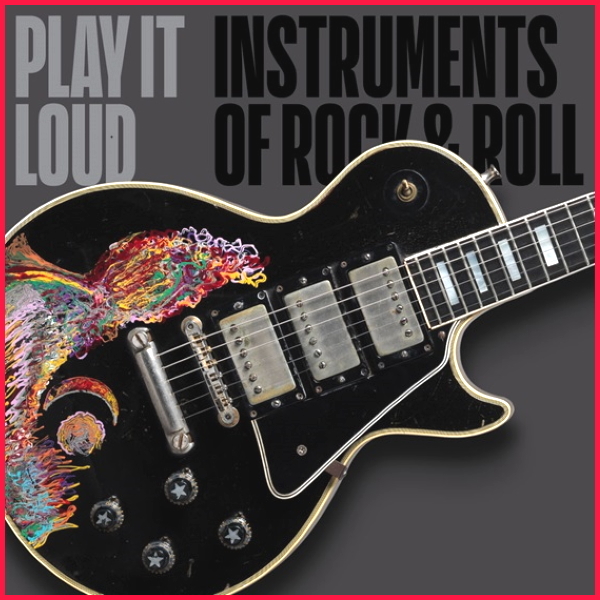News
Play It Loud At The Met Fifth Avenue
3 Sep 19

Iconic guitars played by Eric Clapton are featured in an exhibit at New York’s Metropolitan Museum of Art.
Play It Loud is curated by The Metropolitan Museum of Art and the Rock & Roll Hall of Fame to celebrate the instruments that gave rock and roll its signature sound. On display are over 130 instruments that have been used by the most important musicians in the genre’s history from the fifties to the present day.
Eric Clapton, as the first superstar instrumentalist of his generation, is well represented. Guitars used by Eric at different points in his career help highlight the sound, visual imagery and iconic moments in rock music history.
Play It Loud: The Instruments of Rock and Roll is organized thematically so visitors can explore how musicians advanced emerging and experimental technologies, the Guitar Gods Phenomenon, the crafting of a visual identity through the use of instruments and costumes, and genre-defining moments.
In the section dedicated to “Guitar Gods”, Eric’s most famous guitar, the composite Fender Stratocaster Blackie, is highlighted. At a time when the model had largely fallen out of fashion, Eric purchased several Stratocasters in Nashville in 1970. Assembled from a 1956 body, a 1957 neck and fifties era pickups, Blackie was first played live at the Rainbow Theatre on January 13, 1973. Blackie became Eric’s main recording and performance instrument until 1985. Blackie was also the template for Fender’s ‘Eric Clapton Signature Stratocaster’ model which went into commercial production in 1988. The original instrument was the centerpiece of a charity auction to benefit Crossroads Centre Antigua in 2004. At the time, the $959,500 was a new world record price for a guitar.
In the latter half of Cream’s existence, Eric’s sound and style were exemplified by his use of “The Fool” guitar. It is a centerpiece in the galleries dedicated to image. In 1967, a Dutch art collective founded by Marikjke Koger and Simon Posthuma were commisioned to paint a psychedelic set of instruments for the band. Eric’s 1964 Gibson Les Paul SG became known as “The Fool” after the art collective. The instrument was played extensively on stage by Eric and used for recording sessions. The heavily worn original headstock is also on display. It was removed in the 1970s when then-owner Todd Rundgren restored the guitar to playing condition which included replacing heavily worn parts. Both items are now in private collections.
The Fender bass the artists painted for Eric’s Cream bandmate, Jack Bruce, is on view in an adjacent case.
In the final gallery, two instruments that were used at groundbreaking performances are surrounded by posters that recall legendary events. One is the 1954 Fender Stratocaster used by Bob Dylan when he debuted his electric band at the Newport Folk Festival in 1965. In the adjacent case is the C.F. Martin 000-42 played by Eric at his 1992 appearance on MTV Unplugged; a pivotal moment in his career. Explanatory remarks by the curators credit Eric’s performance with a cultural shift in rock that ushered in a new era of acoustic and roots music and revived interest in Martin’s 000-style instruments. Like Blackie, Eric sold this instrument at auction in 2004 to raise funds for Crossroads Centre Antigua. It’s hammer price of $791,500 set a new sale record for an acoustic guitar at the time. The guitar is now in a private collection.
Other key instruments on display include an early electric guitar prototypes built by Les Paul and Leo Fender; acoustic guitars used by Elvis Presley, Buddy Holly and the Everly Brothers; George Harrison’s first electric guitar; Jimi Hendrix’s “Love Drops” Gibson Flying V; Eddie Van Halen’s “Frankenstein”; Jerry Garcia’s “Wolf”; Stevie Ray Vaughan’s “Number One”; Prince’s Love Symbol guitar; Ringo Starr’s first Ludwig drum kit; drums from Keith Moon’s “Pictures of Lily” drum set; James Jamerson’s upright bass; Jack Bruce’s psychedelic bass; Jerry Lee Lewis’ Grand Piano; a Mellotron MKII owned by the Rolling Stones and Keith Emerson’s keyboard rig. There are also vintage posters, costumes, performance videos and specially filmed interviews throughout the exhibit to illustrate rock music’s history, visual style and impact.
Play It Loud: The Instruments of Rock and Roll runs through October 1 at The Metropolitan Museum of Art in New York City. Allow at least one hour to view the exhibit, three for a deep-dive.
Can’t get to The Met? Check out Play It Loud on the museum’s website:
Exhibition Introduction at https://www.metmuseum.org/primer/play-it-loud#introduction
Exhibition Overview at https://www.metmuseum.org/exhibitions/listings/2019/play-it-loud
Exhibition Objects at https://www.metmuseum.org/exhibitions/objects?exhibitionId=d4024ef6-623f-4770-a626-a38b90c25b64&pkgids=569
